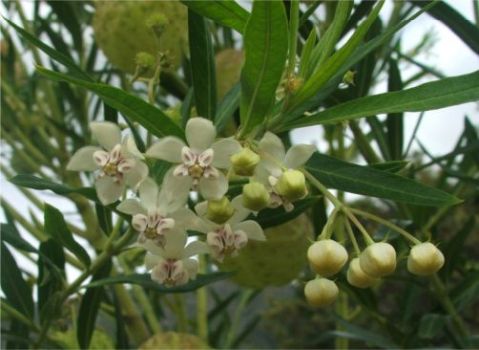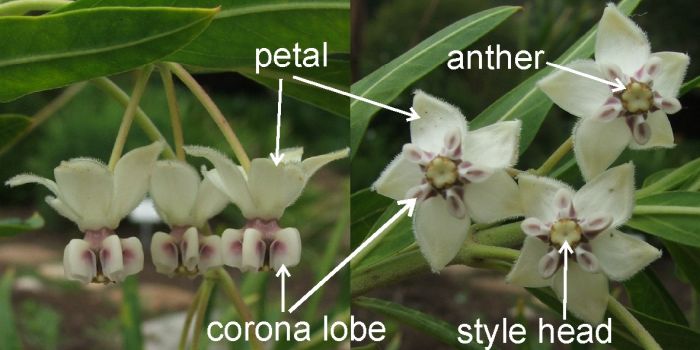Gomphocarpus physocarpus
Gomphocarpus physocarpus E.Mey.
Family: Apocynaceae
Common names: balloon milkweed, balloon wild cotton, hairy balls, bindweed (Eng.); balmelkbossie, balbossie, wilde kapok (Afr.); umbababa, umbemiso, umangwazane, umqumnqwewe, uphuphuma, usingalwesalukazi, umsingalwesalukazi (Zulu) = Asclepias physocarpa (E.Mey.) Schltr.
Introduction
Gomphocarpus physocarpus has striking yellowish, ball-like fruits and is an excellent butterfly plant, but it is poisonous if ingested; so keep it away from small children and livestock.

Description
Description
Gomphocarpus physocarpus is an upright, soft shrub 0.5 to 2 m tall with a fibrous rootstock. Branches arise above a small, single-stemmed trunk. The branches are pale yellowish green and hollow. The leaves are light green, opposite, and narrowly oblong to lance-shaped. Cream to white flowers in pendulous clusters are borne almost throughout the year but mainly during summer (November to April). The flowers are attractive and have a complicated structure. The petals bend strongly backwards, arching over the flower. In the centre of the flower is the corona, consisting of five pouched lobes that develop from the petals. The petals are white and the corona is suffused with pink or purple.

The corona surrounds the male (stamens) and female (carpels, composed of ovary, style & stigma) structures. The filaments of the stamens are fused to form a staminal column which encloses the female part. The female part consists of two free carpels, the tips of which are united and enlarged to form the style head. This is the yellowish, 5-lobed disc that can be seen at the centre of the flower. The anthers are fused to the style head. The pollen grains of each anther lobe are united to form two waxy masses known as pollinia or pollen sacs. Flowers are followed by large spherical inflated fruits covered with soft spines, splitting to release many seeds, each with a tuft of long silky hairs attached at one end.

Please take note: when broken, all parts of this plant exude milky white latex that is poisonous if ingested.
Conservation Status
Status
Least Concern (LC). Gomphocarpus physocarpus is not threatened, according to the Red List of South African Plants.
Distribution and habitat
Distribution description
Gomphocarpus physocarpus is widespread in South Africa, occurring in the Western Cape, Eastern Cape, Kwa-Zulu Natal, Mpumalanga, Gauteng, Limpopo, North West, as well as in Swaziland, Botswana, Zimbabwe and Mozambique and northwards to Kenya. It is found growing in grassland and bushveld, often along roadsides and in disturbed areas, from the coast to 900 m above sea level. Although naturalised and widespread in South Africa for some time, it is an introduced weed, native to tropical Africa.
Derivation of name and historical aspects
History
The genus Gomphocarpus is derived from the Greek gomphos meaning a club, and karpos, fruit. The species name physocarpa is derived from the Greek physa meaning bladder and karpos, fruit, referring to the inflated, bladder-like fruits.
Gomphocarpus is a difficult genus to pin down taxonomically. In the past it has been lumped into a more broadly defined genus Asclepias L. but the current thinking is to retain the more narrow generic concept. The genus Gomphocarpus comprises 25-32 species that occur in Africa and the Arabian Peninsula. Ten species occur in southern Africa.
Gomphocarpus was previously in the family Asclepiadaceae, but this family is now classified as a subfamily, Asclepiadoideae, in the family Apocynaceae. Members of the Asclepiadoideae have highly specialised flowers with complicated pollination mechanisms, and include the milkweeds (Asclepias, Gomphocarpus, Xysmalobium), carrion flowers (Stapelia, Huernia and Hoodia) and curiosities like Bushman's pipe (Ceropegia).

Ecology
Ecology
Pollination of Gomphocarpus physocarpus and its Asclepiad relatives is highly specialised. It usually involves trapping the leg or proboscis of the pollinator so that the pollinia get attached to it, and then a similar process, in the next flower visited, to trap the insect again but this time to remove the pollinia. A recent study in South Africa by Coombs, Peter and Johnson has determined that this species is pollinated by a wide variety of vespid wasps in the genera Belonogaster and Polistes.
Gomphocarpus physocarpus is self-incompatible (i.e. it cannot set seed unless it receives pollen from a different plant), yet is also a successful weed in many places far from its original home. A study in Australia by Forster found Gomphocarpus physocarpus pollinia on a variety of insects but only wasps and hornets were observed regularly re-inserting the pollinia to effect pollination. This shows that its pollination procedure, although specialised, can be successfully performed by similar wasps in other parts of the world.
The seeds are dispersed by wind, aided by the tuft of silky hairs attached to each seed.
Gomphocarpus physocarpus is a food plant for the larva of the African monarch butterfly (Danaus chrysippus orientis). The caterpillars are immune to the poisonous alkaloids in Gomphocarpus and have developed the ability to store them and pass them on to the pupa and adult butterfly, which use them to their own advantage and are foul-tasting and poisonous to predators. The anti-predator strategy of Gomphocarpus has thus been hijacked by the African monarch.
Gomphocarpus physocarpus has been introduced to many countries. It has naturalised and is a weed in Australia, Hawaii, the Americas and the Mediterranean.

Uses
Use
Gomphocarpus physocarpus is widely used in traditional medicine in South Africa. The roots are used to treat stomach ache. Leaves are dried and ground into a powder that is taken as snuff for headaches. The milky latex is used to treat warts. Seeds are blown away from the pods as a charm to placate the ancestors. The stems are used for fibre. Fresh stems and leaves stuffed into mole holes are said to be an effective deterrent. This plant is poisonous if ingested and has caused death to sheep fed large amounts.
It attracts butterflies, in particular the African monarch, to the garden, both to feed on the nectar in the flowers and to lay their eggs on the plant.
The inflated fruits last well in the vase, when dried, and can be used in fresh and dried floral arrangements. Wash your hands after handling the cut stems and dispose of all clippings.

Growing Gomphocarpus physocarpus
Grow
Gomphocarpus physocarpus is not usually propagated or grown for display at Kirstenbosch, but it has a place in the Useful Plants Garden. It is a quick-growing, short-lived, soft shrub. Grow it in well-drained soil in a sunny position. Feeding with compost and regular watering produces a more bushy, vigorous plant. It can look lanky and scrappy in its second year, and performs best if replaced every year. It can be propagated easily by seed, sown in spring or summer. To harvest the seed, allow the fruits to ripen on the plant and harvest as they start to split open. Keep a close eye on them or bag them, because once the pod splits open, the seeds disperse in the wind.
Gomphocarpus physocarpus is an interesting addition to the herbaceous border or shrubbery, where its unusual spherical fruits add interest and texture. It is also a good plant to attract butterflies to the garden. It must be noted that this plant is poisonous if ingested, so should be planted out of the reach of young children.
References
- Claasens, A.J.M. 2005. Butterflies of the Western Cape, a guide to common garden, park and wayside butterflies. Sunbird Publishing.
- Coombs, G., Peter, Craig. I. & Johnson, Steven, D. 2008. A test for Allee effects in the self-incompatible wasp-pollinated milkweed Gomphocarpus physocarpus. Austral Ecology 34 (6): 688-697.
- Forster, Paul, I. 1994. Diurnal insects associated with the flowers of Gomphocarpus physocarpus E.Mey. (Asclepiadaceae) an introduced weed in Australia. Biotropica 26 (2): 214-217.
- Fabian, A. & Germishuizen, G. 1982. Wild flowers of northern South Africa. Fernwood Press, Cape Town.
- Goldblatt, P. & Manning, J. 2000. Cape Plants. A Conspectus of the Cape Flora of South Africa. Strelitzia 9. National Botanical Institute, Pretoria & Missouri Botanical Garden Press, Missouri.
- Goyder, D. 2001. Gomphocarpus (Apocynaceae: Asclepiadaceae) in an African and a global context - an outline of the problem. Biol.Skr. [Author: give title in full] 54: 55-62.
- Hutchings, A., Scott, A.H., Lewis, G. & Cunningham, A.B. 1996. Zulu medicinal plants: an inventory. University of Natal Press, Pietermaritzburg.
- Leistner, O.A. (ed.). 2000. Seed plants of southern Africa : families and genera. Strelitzia 10. National Botanical Institute, Pretoria.
- Pooley, E. 1998. A Field Guide to wild flowers of KwaZulu-Natal and the Eastern Region. Natal Flora Publications Trust, Durban.
- Smith, C.A. 1966. Common names of South African plants. Memoirs of the Botanical Survey of South Africa No. 35.
- South African Butterfly Conservation Assessment, Virtual Museum. www//vmus.adu.org.za.
- Trinder-Smith, Terry H. 2003. The Levyns Guide to the plant genera of the Southwestern Cape. Bolus Herbarium, University of Cape Town, Cape Town.
Credits
Alice Notten
Kirstenbosch National Botanical Garden
January 2010
Plant Attributes:
Plant Type: Perennial, Shrub
SA Distribution: Eastern Cape, KwaZulu-Natal, Limpopo, Mpumalanga, North West, Western Cape
Soil type: Sandy, Loam
Flowering season: Early Summer, Late Summer, Autumn
PH: Acid, Neutral
Flower colour: White, Cream
Aspect: Full Sun, Morning Sun (Semi Shade), Afternoon Sun (Semi Shade)
Gardening skill: Easy
Special Features:
Horticultural zones











Rate this article
Article well written and informative
Rate this plant
Is this an interesting plant?
Login to add your Comment
Back to topNot registered yet? Click here to register.